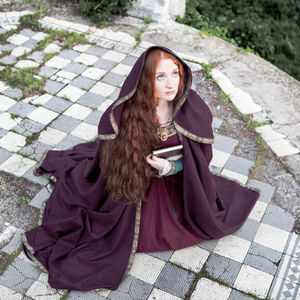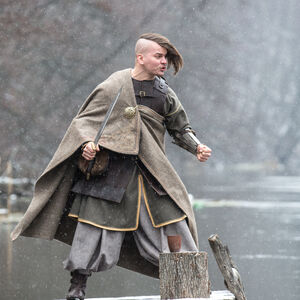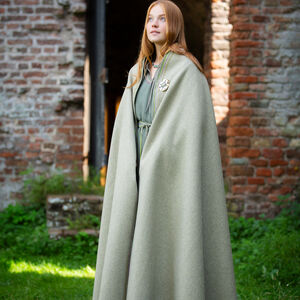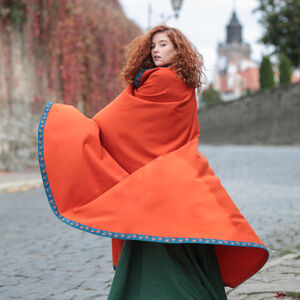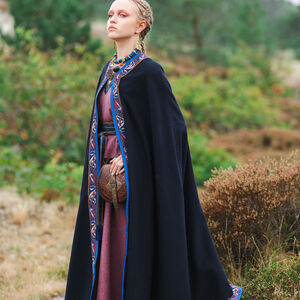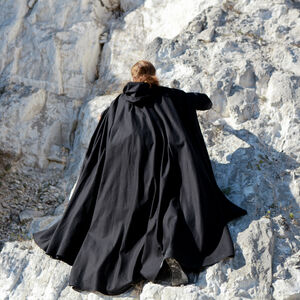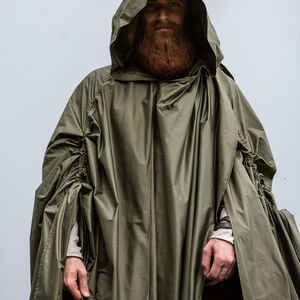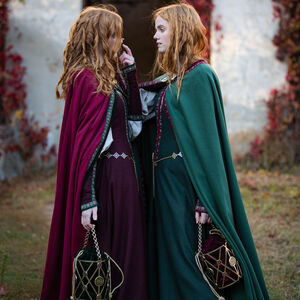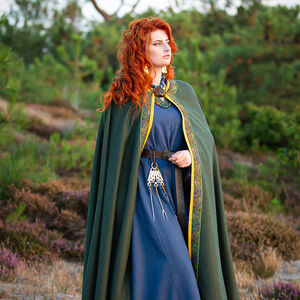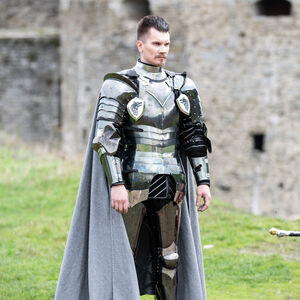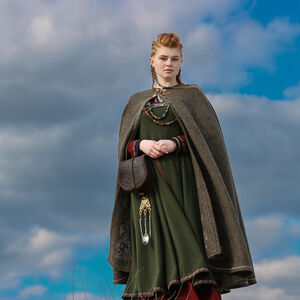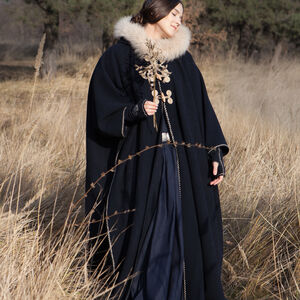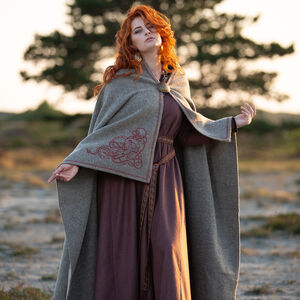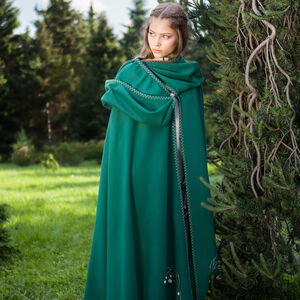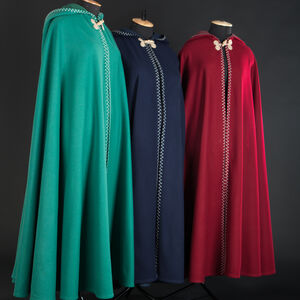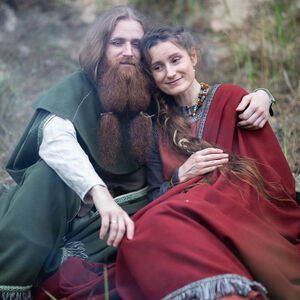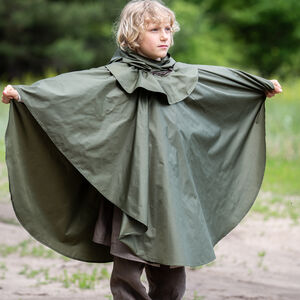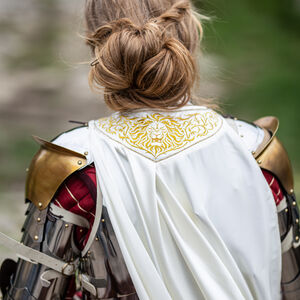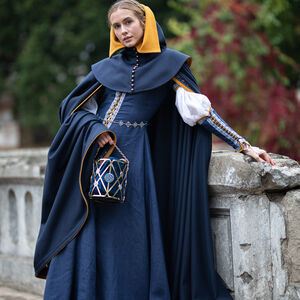Medieval Cloak
Typically the word cloak implies to a long, loose outer garment often with a hood. Cloaks and capes were a part of human clothes for thousands of years, so the first people wore animal skins, serving both as clothing and blankets.
Middle Ages cloaks were the main outer clothing of the era, so they involve a multitude of materials and decoration. In our medieval cloaks store, one can find lined and unlined models made of authentic materials, such as wool, velvet, and cotton. If you’re up for buying a woolen medieval cloak or a renaissance cloak, we'd recommend you learning about the basic period models, to ensure it fits your LARP or reenactment wardrobe
Fantasy Cloaks and Capes
Fantasy comes hand in hand with history in our shop, so choosing a long fantasy cloak or a short cape won't be a problem, whether you're visiting a Renaissance Fair or an immersive LARP event. We make all types of classic medieval cloaks for knights, warriors, and princesses, and, as usual, ArmStreet provides the best quality wool, linen, cotton, and velvet as your selection of materials. Do not hesitate to ask us a question - we do take custom commissions and customize our clothes as well as have a great choice of pre-made fantasy cloaks and capes in stock
A Historical Cloak for Reenactment
Archaeological excavations are the main source for modeling of the period clothes. It should be noted though that being organic, textiles hardly preserve to the present day, which complicates the process of recreating the look of medieval cloaks, as the researchers keep only rare pieces of fabric that can be interpreted as a cloak. Shapes and styles are assumed on the basis of positions of the tissue pieces, the remnants of the seams, pictorial sources, written data and ethnography.
Fantasy cloaks for different characters
Do you need a fantasy-looking cloak for your LARP character or SCA persona, or just looking to appear in style at the Renaissance Fair event? Are you ready to take your LARPing to the next level? Look no further than our amazing selection of cloaks that are perfect for matching different characters!
Whether you're a noble knight, a mysterious wizard, a cunning rogue, or a merciless pirate, we have the perfect cloak to complete your look and immerse you in your character.
Our cloaks are different by style, and the most important thing is that our fantasy has no limits, and, any of our creations are one of a kind, while inspired by some period of history and its fashion. From the black hooded cloak to match a lonely hero to bright and mysterious magic robes, we have a great selection of designs and practically endless options to customize our capes.
Viking Cloak
There were several varieties of the Viking Age cloaks. The first and the most common type is a rectangular cloak made of undyed wool fabric, which covered a half of the body, leaving one hand open. They also wore cropped cloaks of semicircle or trapezoid shape, which could be made of dyed fabrics, including two-color and striped. Since the width of the cloth does not exceed half a meter, the cloaks were made of several panels, which could easily be colored. The edge of the cloak could be decorated with embroidery or ornamentation. According to the sagas, the cloaks were fastened with fibulas or straps tied in the front middle of the chest or on the shoulder.
Styles of Medieval Cloaks
Initially, women’s and men’s cloaks of all classes were pretty similar, but over the centuries cloak underwent various changes, and in the 12th century something happened, what might be called the birth of fashion. One trendy style was replaced by another: simple pull-over style cloaks and capes were replaced by a light full-round ‘mantle’ cloak. This loose-fitting cloak was held on the shoulders only by a twisted silken cord or a decorative ribbon. Then, under the influence of Italian fashion, a ‘huque’ cloak gain widespread. Resembling a poncho, it was bell-shaped and had large folds in front. In the 14th century, it gave way to a ‘pelisson’ or pelice - a cloak with the arm slits, often fully-lined. Later it featured the short sleeves or the long bell sleeves and became a true coat in the modern sense of this word.
Knight's Cloak
Besides the tabards, medieval knights wore riding cloaks fastened on the shoulder, leaving the right hand free. They could be decorated with heraldic emblems such as coat-of-arms and protected the armor from moisture and the sun heating.
Templar knights wore white cloak named 'habit', which symbolized purity. Since brothers of the Order fought and died defending Christianity, their cloaks were embellished with a red cross representing martyrdom. It went down in the annals of history as a major symbol of the Templars. Unlike them, Teutonic knights wore black cloaks with white cross trimmed with silver thread, - the well-known emblem of the Teutonic Order.
Traveler's Cloak
Putting on the road, travelers and pilgrims took care of the adequate outer clothes to keep comfortable during bad weather, so they opt for non-dyed warm cloaks made of coarse wool or felt. Fleece for its manufacture was hardly subjected to degreasing, resulting in a thin fatty film formed on the surface of the cloak, which along with dense and rigid thread, made the cloak waterproof.
Advantages of the ArmStreet cloaks:
- historical and fantasy models;
- custom sizes adjusted to your full height;
- natural materials;
- high-quality manufacture;
- international shipping with express option.
LARP cloaks
Our freshest product line from the "Fireside Family" collection offers several types of cloaks, including waterproof practical cloaks with rain hoods to protect you from weather elements. Along with our more historical capes, these cloaks can be an essential part of your comfort while at an LARP or a Renaissance Fair event



